Tina Zukanovic is a fashion womenswear and accessories designer. Prior to joining RCA,she worked in parisian fashion houses Kenzo, Lanvin and Chloe as womenswear designer.
Her points of interests are digital fashion deeply entwined with additive manufacturing technologies, data based analysis, simulations and 3D modeling optimization, to develop innovative cutting edge anatomy-aware footwear.
She likes to explore the next-gen materials to achieve her projects and push boundaries. She also finds inspiration in architecture, parametric design, biomorphology and sci-fi esthetics.
In this project she collaborated with Julien Deffontaines, Paris based architect from Ecole Speciale d’Architecture (ESA) who worked on digital parametric fashion design with Le Musee Des Art Decoratif and the Architectural Association School of Architecture (AA School)














![[untitled]](https://res.cloudinary.com/rca2020/image/upload/f_auto,h_1073,w_1920,c_fill,g_auto,q_auto/v1/rca2021/60e6cad072223f83de38594a-333711?_a=AXAH4S10)

